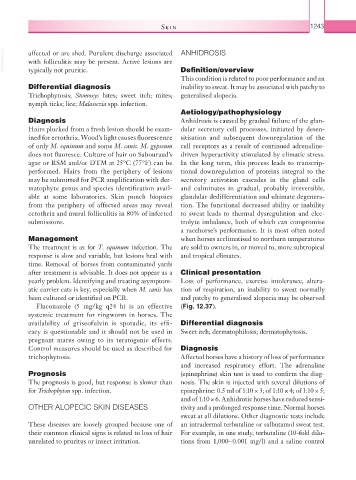Page 1268 - Equine Clinical Medicine, Surgery and Reproduction, 2nd Edition
P. 1268
Skin 1243
VetBooks.ir affected or are shed. Purulent discharge associated ANHIDROSIS
with folliculitis may be present. Active lesions are
Definition/overview
typically not pruritic.
This condition is related to poor performance and an
Differential diagnosis inability to sweat. It may be associated with patchy to
Trichophytosis; Stomoxys bites; sweet itch; mites; generalised alopecia.
nymph ticks; lice; Malassezia spp. infection.
Aetiology/pathophysiology
Diagnosis Anhidrosis is caused by gradual failure of the glan-
Hairs plucked from a fresh lesion should be exam- dular secretory cell processes, initiated by desen-
ined for ectothrix. Wood’s light causes fluorescence sitisation and subsequent downregulation of the
of only M. equinum and some M. canis. M. gypseum cell receptors as a result of continued adrenaline‐
does not fluoresce. Culture of hair on Sabouraud’s driven hyperactivity stimulated by climatic stress.
agar or RSM and/or DTM at 25°C (77°F) can be In the long term, this process leads to transcrip-
performed. Hairs from the periphery of lesions tional downregulation of proteins integral to the
may be submitted for PCR amplification with der- secretory activation cascades in the gland cells
matophyte genus and species identification avail- and culminates in gradual, probably irreversible,
able at some laboratories. Skin punch biopsies glandular dedifferentiation and ultimate degenera-
from the periphery of affected areas may reveal tion. The functional decreased ability or inability
ectothrix and mural folliculitis in 80% of infected to sweat leads to thermal dysregulation and elec-
submissions. trolyte imbalance, both of which can compromise
a racehorse’s performance. It is most often noted
Management when horses acclimatised to northern temperatures
The treatment is as for T. equinum infection. The are sold to owners in, or moved to, more subtropical
response is slow and variable, but lesions heal with and tropical climates.
time. Removal of horses from contaminated yards
after treatment is advisable. It does not appear as a Clinical presentation
yearly problem. Identifying and treating asymptom- Loss of performance, exercise intolerance, altera-
atic carrier cats is key, especially when M. canis has tion of respiration, an inability to sweat normally
been cultured or identified on PCR. and patchy to generalised alopecia may be observed
Fluconazole (5 mg/kg q24 h) is an effective (Fig. 12.37).
systemic treatment for ringworm in horses. The
availability of griseofulvin is sporadic, its effi- Differential diagnosis
cacy is questionable and it should not be used in Sweet itch; dermatophilosis; dermatophytosis.
pregnant mares owing to its teratogenic effects.
Control measures should be used as described for Diagnosis
trichophytosis. Affected horses have a history of loss of performance
and increased respiratory effort. The adrenaline
Prognosis (epinephrine) skin test is used to confirm the diag-
The prognosis is good, but response is slower than nosis. The skin is injected with several dilutions of
for Trichophyton spp. infection. epinephrine: 0.5 ml of 1:10 × 3; of 1:10 × 4; of 1:10 × 5;
and of 1:10 × 6. Anhidrotic horses have reduced sensi-
OTHER ALOPECIC SKIN DISEASES tivity and a prolonged response time. Normal horses
sweat at all dilutions. Other diagnostic tests include
These diseases are loosely grouped because one of an intradermal terbutaline or salbutamol sweat test.
their common clinical signs is related to loss of hair For example, in one study, terbutaline (10-fold dilu-
unrelated to pruritus or insect irritation. tions from 1,000–0.001 mg/l) and a saline control

